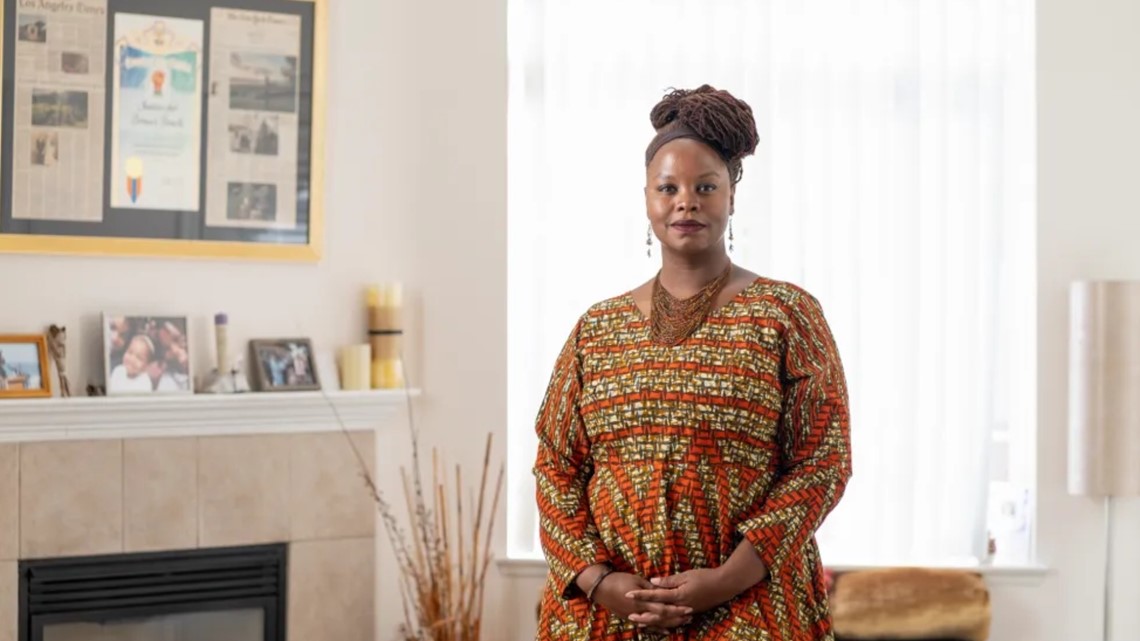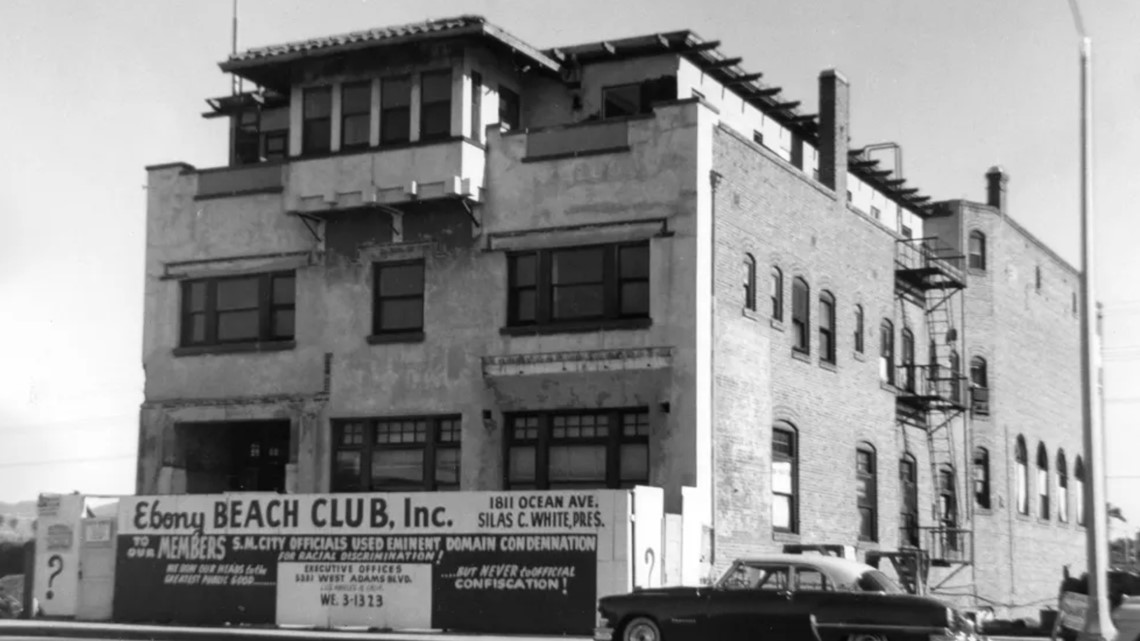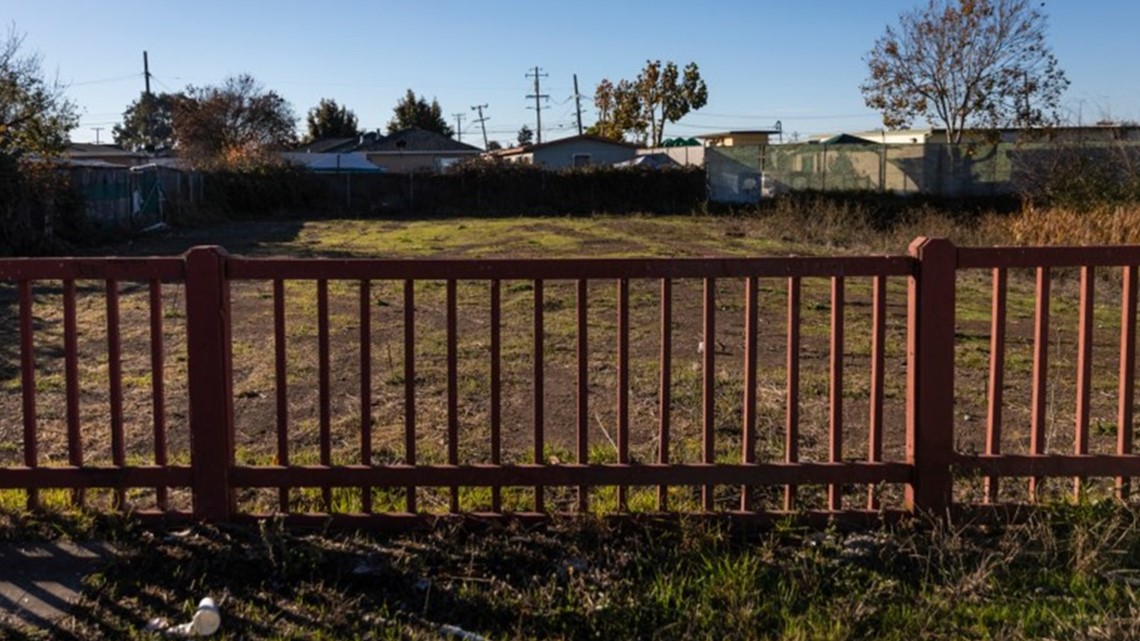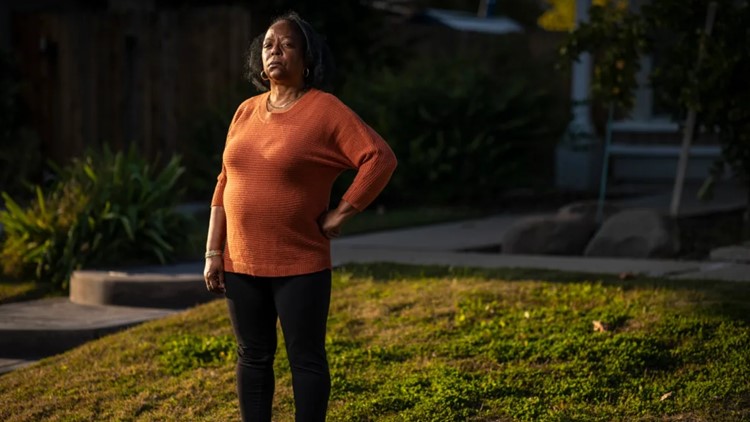CALIFORNIA, USA — This story was originally published by CalMatters.
Beverly Moore recalls feeling a wave of relief when her family rented a house in Richmond, California after their prior house burned down in the late 1950s.
The one-story wooden house at 502 Enterprise Ave. soon became part of a close-knit Black community. There was a porch and a den filled with books. Moore remembers her mom tending to their fig and pear trees with water from their well. Her mother grew collard greens that she traded with neighbors for fresh-caught fish.
Moore held jobs through her teen years and after graduating from Cal State Fresno, she bought that house for her mother in 1980, relieving her from a lifetime of renting.
“It was a privilege to buy our home for my mom; it was something she was unable to do,” Moore said recently.
But their homeownership was short-lived.
In 1993 the city of Richmond seized the home through eminent domain to make way for a drainage system linked to the Richmond Parkway, which connects the city with a bridge into Marin County.
The Moore house was the only home on the block that was demolished.
Eminent domain is when a government takes private property for public use, often to construct roads, highways, schools or for some other public purpose. By law the government is required to provide property owners with “just compensation.”


Coveted property
For decades Black families have borne the brunt of these land grabs, with many like Moore saying they had little or no recourse. Eminent domain still poses barriers to Black homeownership today, contributing to the wealth gap.
Often local governments justified these actions by declaring areas “blighted,” a word advocates say became synonymous with low-income, under-resourced neighborhoods.
“California was at the forefront of this kind of abuse,” said Bob McNamara, a senior attorney at the Institute for Justice, a national libertarian public interest law firm.
“For a long time California treated the concept of blighted property as basically synonymous with coveted property. It was blighted if they wanted it.”
A study of more than 2,532 “blight” projects nationwide found the projects displaced more than 1 million Black Americans from 1949 to 1973. Those were the years the Federal Housing Act first authorized cities to use eminent domain to clear “blighted neighborhoods,” according to the Institute for Justice, authors of the study.
Black people were 12% of the population but two-thirds of those displaced.
“It changed the whole dynamic of everybody’s life,” Moore said of her family’s experience. “We never had that place to come back to, to land, without that support.”
Today Moore, a retired mental health case manager living in Fairfield, believes she has a chance to one day call that land home again.
Last year she reached out to Where Is My Land, an organization that helps Black families across the country regain land taken through eminent domain, fraudulent wills, or other means.
Nearly 500 families have contacted Where Is My Land since the organization launched last summer, said founder Kavon Ward, an activist and poet in Los Angeles.
Hundreds sought help
Demand for the group’s services has been “overwhelming,” she said, adding she is encouraged so many have contacted her.
“I’m happy that there’s hope where there wasn’t,” she said, adding Where Is My Land must be strategic about moving cases forward. “I need there to be realistic expectations.”
For now, Ward said, the group’s three staff members are “taking it slow … we can’t go as fast as people are expecting us to unless they want to donate millions of dollars.”
The for-profit organization says it provides advocacy, research and media consulting and charges between $35 a session to $3,333 for the full package of services.
The hundreds seeking Where Is My Land’s help span the United States, Ward said, with most requests coming from the South and the East Coast. There are 40 active cases, including seven in California, Ward said.
“All of (the cases) are racially motivated,” Ward said, “Eminent domain was used in a lot of them, but also just racist white people running people off the land … There’s fraud and oil companies taking land and getting away with it. We have courts involved with the theft of it … and municipalities and states not doing anything about it, despite seeing that the families have proven evidence that the land belongs to them.”
In California, Where is My Land is working with seven families who lost property to municipalities in Santa Monica, Hayward, Richmond, Coloma, Palm Springs, Canyon and Napa, Ward said. The team is gathering documents and testimony and working with law firms, though Ward wouldn’t be specific about their strategy, saying the organization faces steep opposition.
“I am grateful that more and more people are educating themselves and are ready to make amends,” she said. “But at the same time, there are just as many people who are not and who are looking at this attempt to get land back as a huge threat and will do whatever they can to stop the movement.”
Bruce’s Beach
Where is My Land grew out of a local effort to help a Black family in Manhattan Beach regain ownership of a small park called Bruce’s Beach in Los Angeles County.
In the early 1900s, Bruce’s Beach was a haven for Black families who wanted to swim in the Pacific Ocean but were blocked from most other beaches and pools in the county. Originally owned by Willa and Charles Bruce, the beach was a resort with a restaurant and dance hall.
The city of Manhattan Beach seized the property in 1927, claiming it for a public park. But the spot remained undeveloped for decades. The city deeded it to the state, which transferred it to the county, which put a lifeguard station on it.
Now surrounding the park are multi-million dollar luxury homes with ocean views.
“Can you imagine what that land would be worth?” Ward said. “Can you imagine how wealthy that family could have been?”
Before 2020, Ward said, she barely knew the history of Bruce’s Beach. After the national protests in response to the police murder of George Floyd, she held a Juneteenth picnic at Bruce’s Beach where two members of the Bruce family attended.
“I got so upset,” said Ward, 41. “I live in this city where Black people were essentially co-founders and I had no idea.”
Ward began advocating for the return of the land to the Bruces. She spent hours testifying at city council meetings and before the California Coastal Commission about the unjust history of eminent domain, while facing pushback from residents, including some who called the Bruces opportunists and claimed there was no systemic racism in Manhattan Beach.
Racial motivations
Separately state Sen. Steven Bradford — a Democrat from San Pedro who sits on the state’s reparations task force — had begun drafting Senate Bill 796, which would allow the county to return the land to the Bruces.
Legislators unanimously passed the bill, and in September 2021, Governor Gavin Newsom signed it. L.A. County, while publicly admitting the original land grab was motivated by racial prejudice, deeded the land back to the Bruce family in what many said was a rare case of a government reversing a multimillion-dollar eminent domain action.
“It is well documented that this move was a racially motivated attempt to drive out the successful Black business and its patrons,” the Board of Supervisors’ motion reads.
Recently the county signed an agreement with Bruce descendants to continue leasing the property for $413,000 a year for two years. Afterward the county could buy it from the family for a price “not to exceed” $20 million.
The fight to return the beach met with some legal resistance. Joseph Ryan, a Palos Verdes resident and retired attorney, filed a lawsuit arguing that the land transfer would constitute “a gift” of public funds and therefore is unconstitutional. The Los Angeles Superior Court rejected Ryan’s suit last April, finding the return of land is not a gift.
In an email to CalMatters, he disputed the history of the eminent domain seizure, and referred to his prior statements in which he called the story of injustice a “myth.”
Making it right
Ward said the property’s return to the Bruces is a sign of progress.
“It’s the first time in this frickin’ country, in this world, that Black people are treated with enough respect for this country to say, ‘You know, what we did, this, it was wrong. We’re going to do what we can to make it right,’” Ward said.


Ward’s advocacy, along with Bradford’s first-of-its-kind legislation, put the issue of Black land dispossession on a national stage. Ward said the campaign was a moment of “perfect alignment” of political will among people in local, state and national political spheres.
“There’s no one-size-fits-all model for any of it,” Ward said. “A lot of it is case-by-case strategy.”
Today her organization pushes for property transfers either legislatively or through the courts, along with drumming up public support.
Families submit claims to the organization’s website and the team’s lead researcher, Kamala Miller, reviews them. A strong case, Miller said, is one with robust documentation of ownership by a family — such as property deeds or demolition notices — or historical evidence of eminent domain in local newspapers or city archives.
Miller, who is a licensed attorney in Washington D.C., said cases like the Bruces’ and the Moores’ — involving land seized for public use and which remains unused — have better shots at transfers than cases where private parties seize land.
“Those are more likely to get a listening ear” than when somebody lives on the property, Miller said.
Bradford agreed, adding that since the passage of SB 796, he has spoken with legislators from across the country hoping for a roadmap for future land transfers involving eminent domain.
“SB 796 is a clear example of what can be done when there’s a will by government entities — whether it’s local, state, or federal — to return land that is currently being controlled by government entities,” Bradford said.
A debt owed
He added that a goal for California’s reparations taskforce is to compile a database of properties taken from Black families. The task force, in general, is examining how Black people have been impacted by systemic racism and how the state can respond through reparations.
Bradford makes a distinction between reparations and returning stolen land.
“I see reparations as that which was owed and that which was promised,” Bradford said, “so to return that which was stolen is not necessarily reparations. But it’s an example of what we can do in trying to correct some of the historical wrongs, as it relates to the denial and stealing of property that belonged to Black folks.”
Many properties taken from Black families are now owned or occupied by private people or entities, and there are fewer ways to pursue their return, advocates said.


Constance White, who grew up in Santa Monica, said she has asked Where is My Land to help, because the property her family once owned, though publicly owned, is now the site of the Viceroy Santa Monica hotel, part of a multi-billion dollar hotel group.
Back in 1957 her father, Silas White, was weeks away from opening the Ebony Beach Club, a club for Black people. Signs were on the building — and Nat King Cole was to be one of the first members — when the city of Santa Monica seized the property under the guise of building a parking lot for the civic center, she said.
Soon after his business plans were destroyed, Silas White fell ill. He died in 1962.
The city didn’t build the civic center parking lot; it allowed a hotel to be built there instead. According to the L.A. County Assessor, the city of Santa Monica still owns the land, valued at $1.5 million.
Constance White said the city owes her family a debt.
“I want a real great awareness, an apology from the city of Santa Monica,” said White, who is 88. “And since I can’t get the land back, I would think there’s something financial that they would be willing to do.”
Apologies for racism
At a November city council meeting, Santa Monica Mayor Sue Himmelrich and the council issued a formal apology to the African American community, acknowledging the city’s “deed restrictions, prohibitive zoning, and racist realtor practices,” including the use of eminent domain.
The council said it is committed to “ferreting out and overturning systemically racist policies to ensure that the pain caused by several decades of racial injustice and discrimination against African Americans and other people of color is mitigated to the extent possible.”
City officials were not available to comment specifically on White’s case.
George Fatheree, an LA attorney who represented the Bruce family, said Black people won’t be able to litigate themselves out of historical real estate discrimination. Changes in government policies will be necessary.
“It’s a function of decades, if not centuries, of racially discriminatory acts and policies and laws. The idea that the way to address it through one-by-one litigation is somewhat myopic,” he said.


In Moore’s case, the city of Richmond paid her $27,000 in 1993 for the house on Enterprise Avenue. The city also helped relocate Moore’s mother to a senior home and her brother to an affordable housing unit.
But that wasn’t enough to remedy the incalculable loss, Moore said; soon after, depression blanketed her mother’s already declining health.
Two decades after the house was demolished, the 6,032-square-foot plot is an empty field of weeds. The city considers it surplus and has put it up for sale. The county assessor valued it at $13,540 in January.
“The real question is whether the previous owner was paid a fair price when the parcel was obtained through eminent domain,” said Tom Butt, Richmond’s current mayor, in an email to CalMatters.
Moore said she and her adult daughter are ready to fight for it. They dream of opening a community garden or a senior center on their family’s plot.
“It brings back so many memories – and they’re fading because the house is not there,” Moore said. “We’re not there. We’re not able to be in our home … That was our whole livelihood. When they took the foundation, everything started crumbling.”



